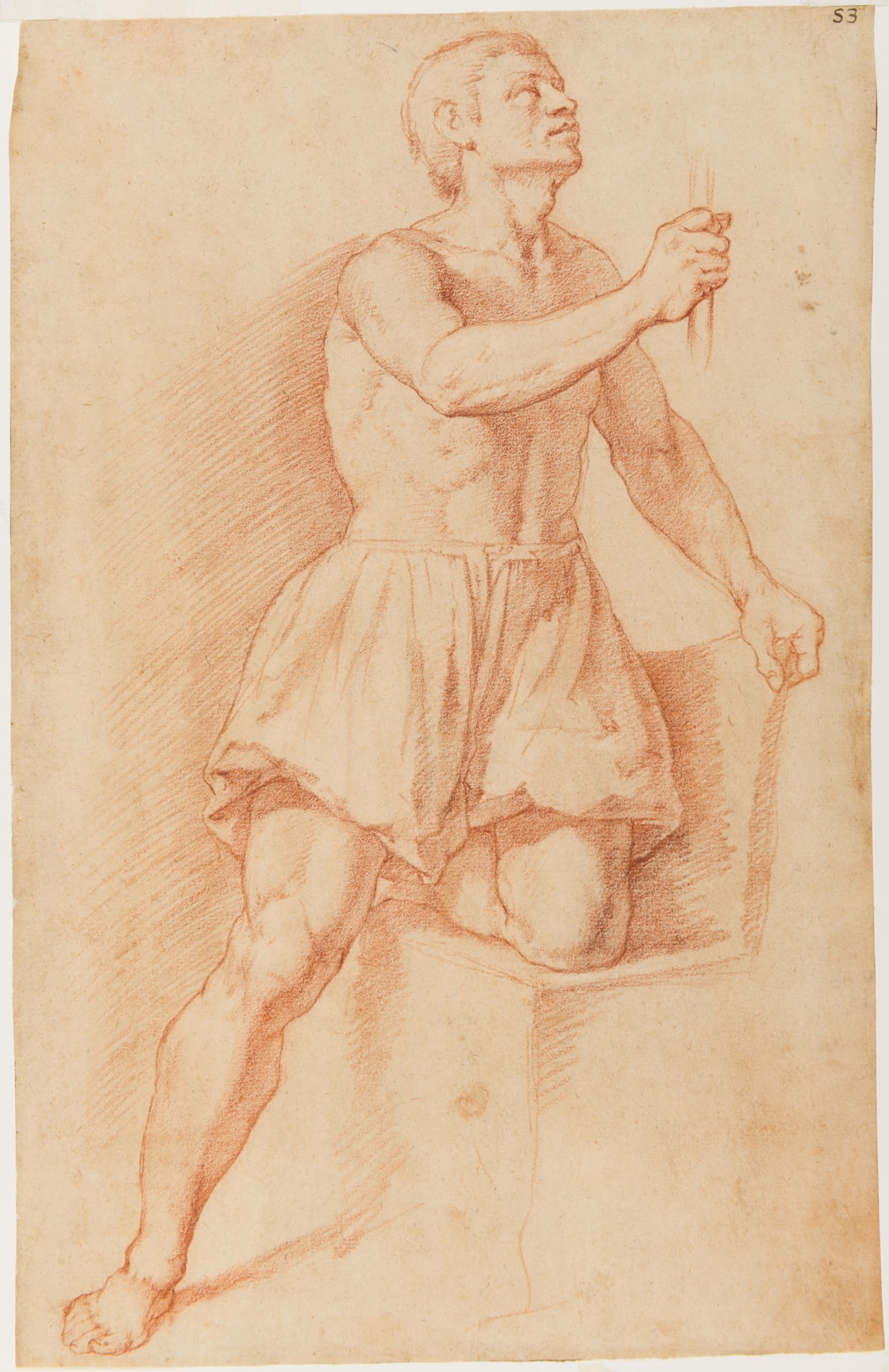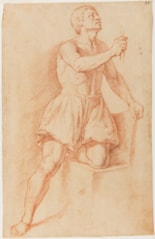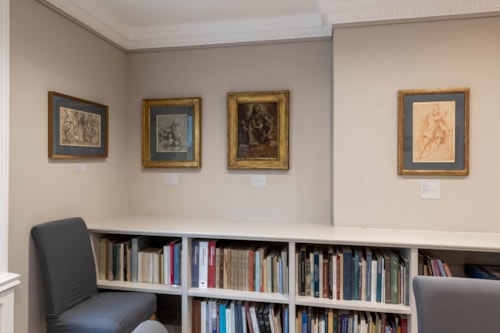Bartolomeo CESI
(Bologna 1556 - Bologna 1629)
A Young Man Wearing Pantaloons
Red chalk on buff paper.
Numbered 53 at the upper right.
Inscribed Mattia Roselli on the former mount.
398 x 256 mm. (15 5/8 x 10 1/8 in.)
Numbered 53 at the upper right.
Inscribed Mattia Roselli on the former mount.
398 x 256 mm. (15 5/8 x 10 1/8 in.)
Although it remains unconnected to any surviving work by the artist, the present sheet is a fine example of Bartolomeo Cesi’s figure studies, which are often drawn in red chalk on blue or buff paper. Inspired by the example of the Carracci, Cesi produced preparatory figure studies for his paintings that were invariably drawn from life, using models – probably workshop assistants - posed in his studio. (Indeed, Cesi’s drawings have often in the past been attributed to one or another of the Carracci, although his drawings may be distinguished by a somewhat lighter application of chalk.) Malvasia writes of Cesi that his drawings of single figures - ‘drawn from the model with so much assurance and facility’, as he writes - were more popular with the collectors of his own day than the artist’s composition studies. He adds that, although Cesi always worked from a posed model, due to his innate modesty he almost never drew studies of nudes or anatomical studies, unlike the Carracci.
This drawing was formerly laid onto a 17th or early 18th century Italian mount which bore an attribution to the Florentine artist Matteo Rosselli (1578-1650). Indeed, the drawing displays striking similarities with the work of Tuscan artists of the late 16th and early 17th centuries. As Nancy Ward Neilson has noted, ‘Cesi’s drawing style…is as strongly indebted to Tuscan draughtsmanship – to, for example, that of Jacopo da Empoli – as to any other precedent. Further, Bartolomeo is also documented in Tuscany in the 1590’s, specifically in Siena in 1594 where he was at work in the Certosa di Maggiano. Doubtlessly, Cesi’s experience of Rome and Tuscany were fundamental in his formation of a clear, austere reform style, one which became evident by the 1590’s...’
A stylistically comparable red chalk study of a reclining male nude is one of several drawings by Bartolomeo Cesi in the collection of the Martin von Wagner Museum in Würzburg, while a drawing of Two Youths Embracing in the Uffizi is also similar to the present sheet, as is a study of a Male Nude Holding a Pole in the Koenig-Fachsenfeld collection at the Staatsgalerie in Stuttgart.
Cesi often used the same models repeatedly, and the distinctive physiognomy of the youth in the present sheet – who is likely to have been a garzone, or studio assistant - is found in several other drawings by the artist, including a study of an apostle in the Louvre and two others at Christ Church in Oxford.
This drawing was formerly laid onto a 17th or early 18th century Italian mount which bore an attribution to the Florentine artist Matteo Rosselli (1578-1650). Indeed, the drawing displays striking similarities with the work of Tuscan artists of the late 16th and early 17th centuries. As Nancy Ward Neilson has noted, ‘Cesi’s drawing style…is as strongly indebted to Tuscan draughtsmanship – to, for example, that of Jacopo da Empoli – as to any other precedent. Further, Bartolomeo is also documented in Tuscany in the 1590’s, specifically in Siena in 1594 where he was at work in the Certosa di Maggiano. Doubtlessly, Cesi’s experience of Rome and Tuscany were fundamental in his formation of a clear, austere reform style, one which became evident by the 1590’s...’
A stylistically comparable red chalk study of a reclining male nude is one of several drawings by Bartolomeo Cesi in the collection of the Martin von Wagner Museum in Würzburg, while a drawing of Two Youths Embracing in the Uffizi is also similar to the present sheet, as is a study of a Male Nude Holding a Pole in the Koenig-Fachsenfeld collection at the Staatsgalerie in Stuttgart.
Cesi often used the same models repeatedly, and the distinctive physiognomy of the youth in the present sheet – who is likely to have been a garzone, or studio assistant - is found in several other drawings by the artist, including a study of an apostle in the Louvre and two others at Christ Church in Oxford.
According to his biographer Carlo Cesare Malvasia, Bartolomeo Cesi was a pupil of Giovanni Francesco Bezzi, known as Nosadella. His earliest documented works are a series of frescoes in the Vezza chapel in the church of Santo Stefano in Bologna, executed in 1574 when he was only eighteen years old. At around the same time he also worked in the church of San Pietro in Bologna, alongside Prospero Fontana and Camillo Procaccini. While Cesi’s early work reflects the influence of the Bolognese Mannerism of his elders, a presumed trip to Rome in 1591 exposed him to a more restrained, Counter-Reformation style of painting that he adopted in his mature work. In Bologna between 1594 and 1595 Cesi painted a fresco cycle of the Life of the Virgin in the church of Santa Maria dei Bulgari, largely destroyed during the Second World War, and in 1595 also completed an Adoration of the Magi for San Domenico. By this time he was well established as one of the foremost religious painters in Bologna, painting numerous works for local churches as well as smaller devotional pictures for private patrons.
At the turn of the century Cesi was employed on the fresco decoration of several rooms in the Palazzo Fava, through which he came into close contact with the work of the Carracci, whose frescoes for the same palace had been completed a few years earlier. This was, however, one of the few secular commissions he undertook. Cesi’s work is almost entirely religious in subject matter, and the artist remained closely associated with several monastic orders throughout his long career. Among his significant works of the 1590s are frescoes for the Palazzo Comunale in Imola and an altarpiece for San Domenico in Bologna. For the latter church he also participated in the decoration of the chapel of the Rosary in 1601, in collaboration with Guido Reni and Ludovico Carracci. Among his more important later projects were several frescoes and paintings of Carthusian saints and subjects for the choir of the Certosa of Bologna, generally dated between 1612 and 1616. After this point, however, his output seems to have declined considerably in the last decade of his life.
The largest extant group of drawings by Bartolomeo Cesi is today in the collection of the Uffizi in Florence, and significant groups are also in the Palazzo Rosso in Genoa and the Martin von Wagner Museum in Würzburg. Other drawings by the artist are in the Museo Civico in Bassano, the Pinacoteca Nazionale in Bologna, the Fitzwilliam Museum in Cambridge, the Art Institute of Chicago, the British Museum and the Courtauld Institute Galleries in London, the Los Angeles County Museum of Art, the Museo del Prado in Madrid, the Pinacoteca di Brera in Milan, the Metropolitan Museum of Art in New York, the Fondation Custodia and the Louvre in Paris, the Boijmans Van Beuningen Museum in Rotterdam, the Staatsgalerie in Stuttgart, the Albertina in Vienna, the Royal Library at Windsor Castle, and elsewhere.
Provenance
An anonymous 17th or 18th century Florentine collection, possibly that of Giuseppe Santini, Florence
Comte Eugène d’Oultremont, Chateau de Presles, Aiseau-Presle, Belgium, and thence by descent until 1985
Anonymous sale (‘The Property of a Nobleman’), London, Christie’s, 12 December 1985, lot 202 (as Matteo Rosselli)
Marcello Aldega, Rome, and Margot Gordon, New York, in 1986
Private collection.
Comte Eugène d’Oultremont, Chateau de Presles, Aiseau-Presle, Belgium, and thence by descent until 1985
Anonymous sale (‘The Property of a Nobleman’), London, Christie’s, 12 December 1985, lot 202 (as Matteo Rosselli)
Marcello Aldega, Rome, and Margot Gordon, New York, in 1986
Private collection.
Literature
Alberto Graziani, Francesco Abbate and Mario di Giampaolo, Bartolomeo Cesi, Bussero, 1988 (1939), p.156, fig.84; Alessandro Zacchi, ‘Bartolomeo Cesi fra tarda maniera e riforma caraccesca: nuove proposte per il catalogo dei disegni’, Arte Cristiana, March-April 1991, p.120; Brookline and New York, Nissman, Abromson & Co., Master Drawings 1500-1900, exhibition catalogue, n.d. (1992), under no.15; Alessandro Zacchi, ‘Bartolomeo Cesi disegnatore’, in Vera Fortunati and Vincenzo Musumeci, Bartolomeo Cesi e l’affresco dei canonici Lateranensi, Fiesole, 1997, p.135.
Exhibition
New York, Margot Gordon, and Rome, Marcello Aldega, Italian Drawings of the XVI Century, 1986, no.40; Stanford University, Cantor Center for Visual Arts, Classic Taste: Drawings and Decorative Arts from the Collection of Horace Brock, March-May, 2000.





